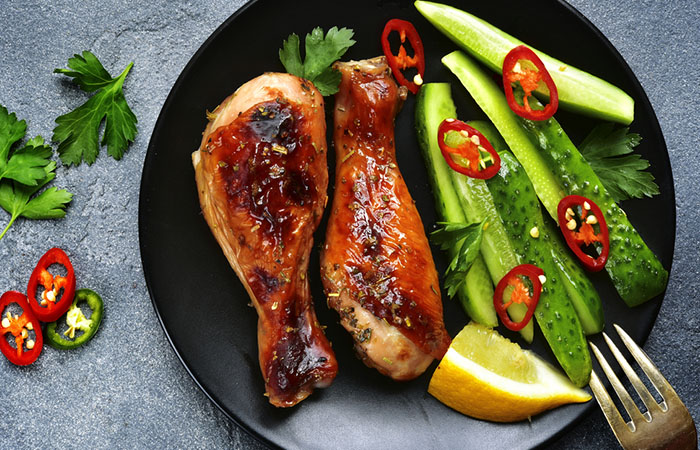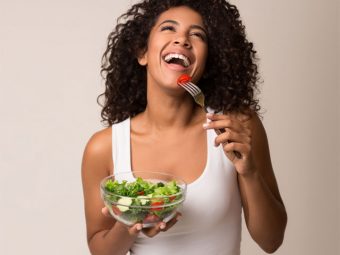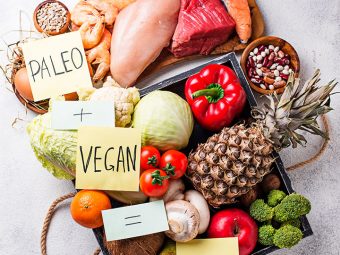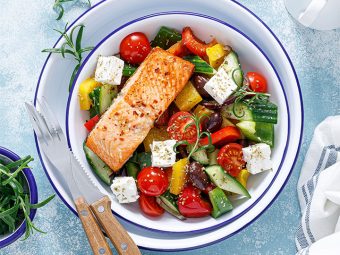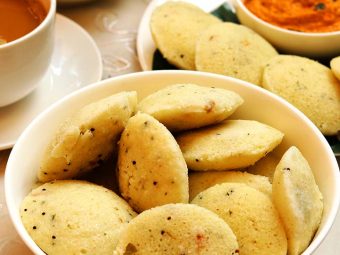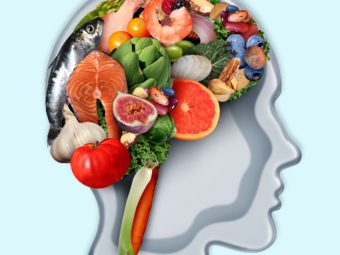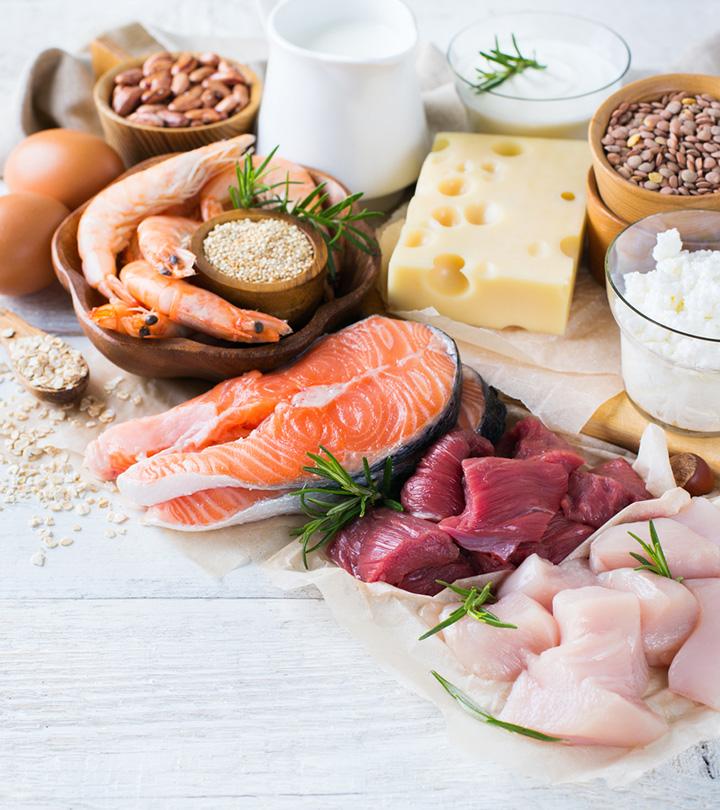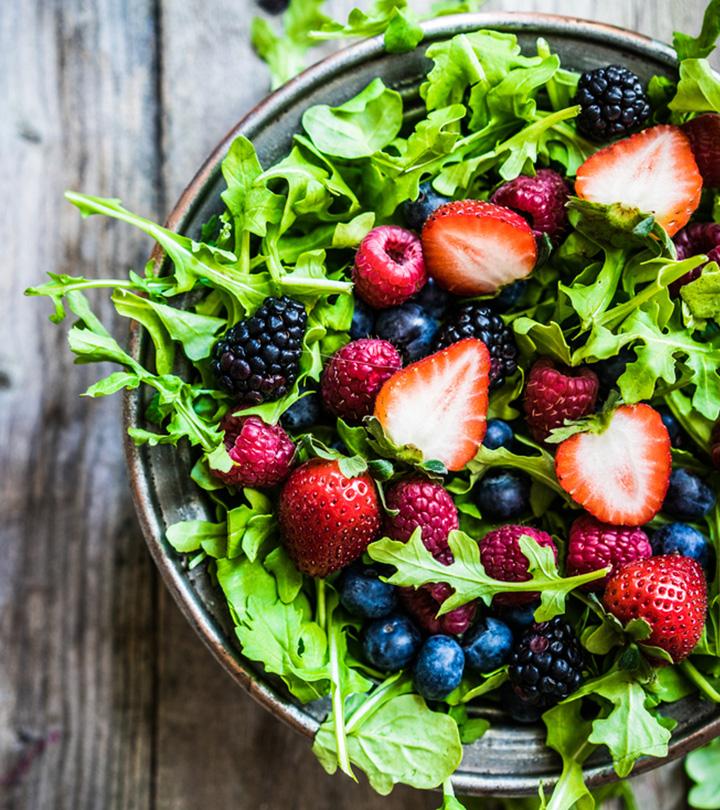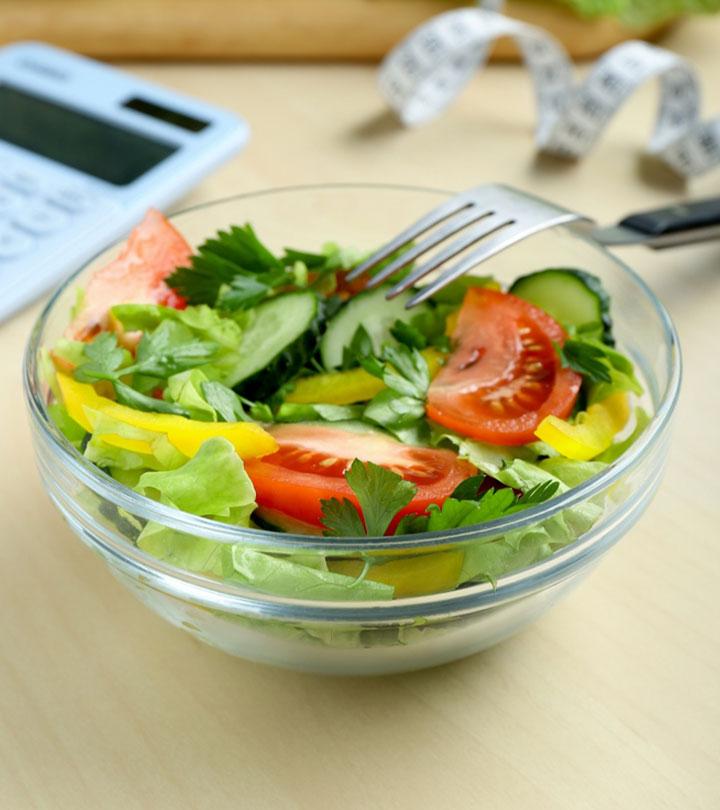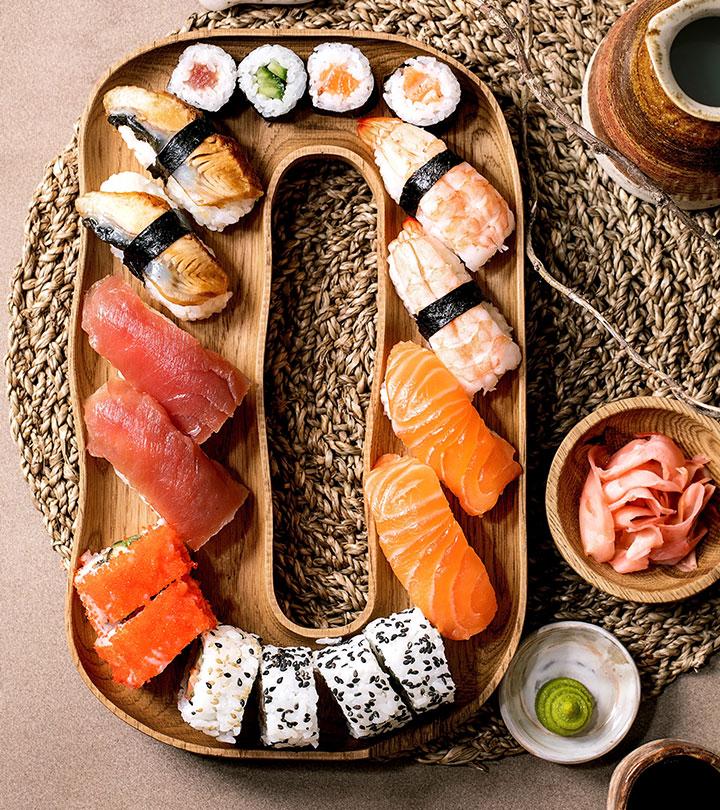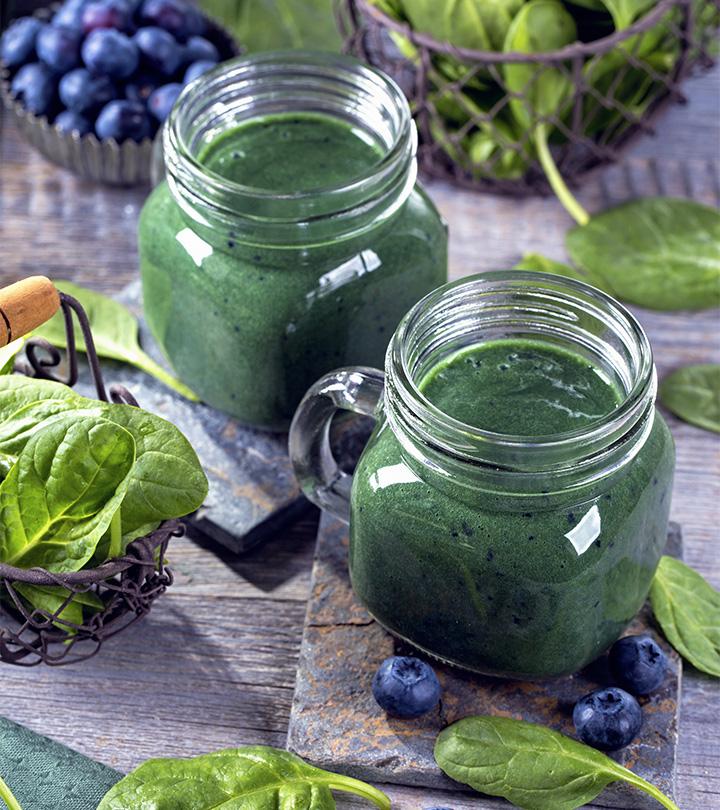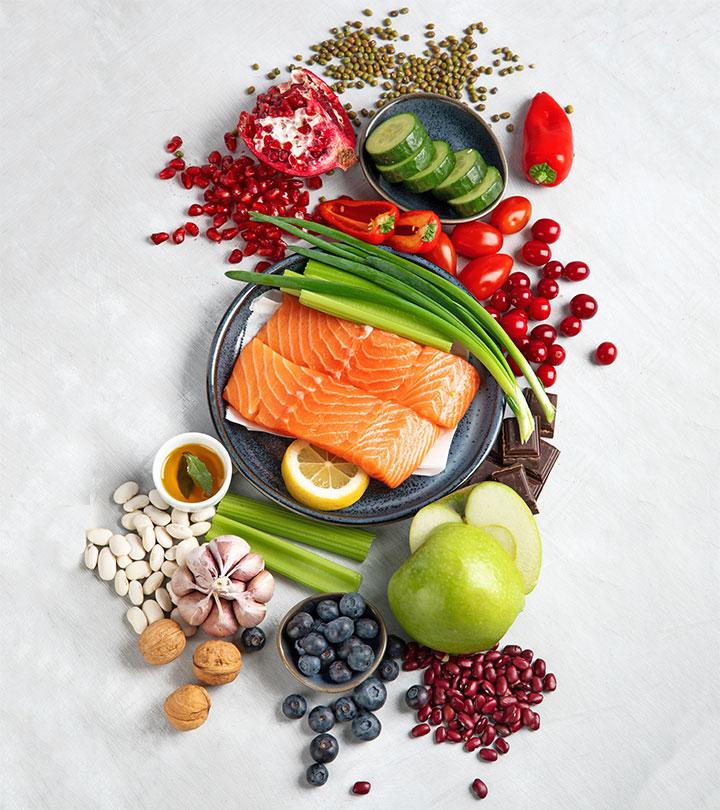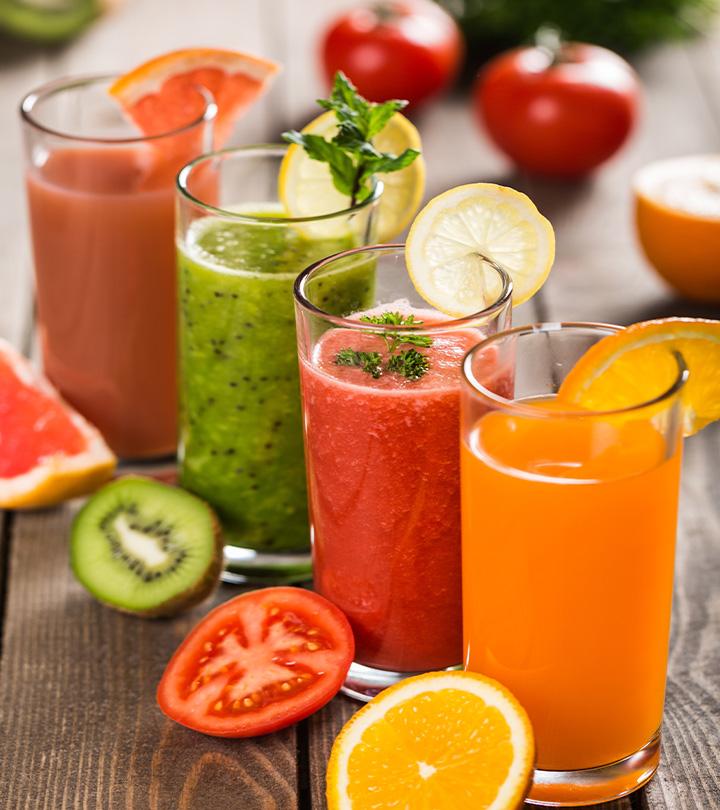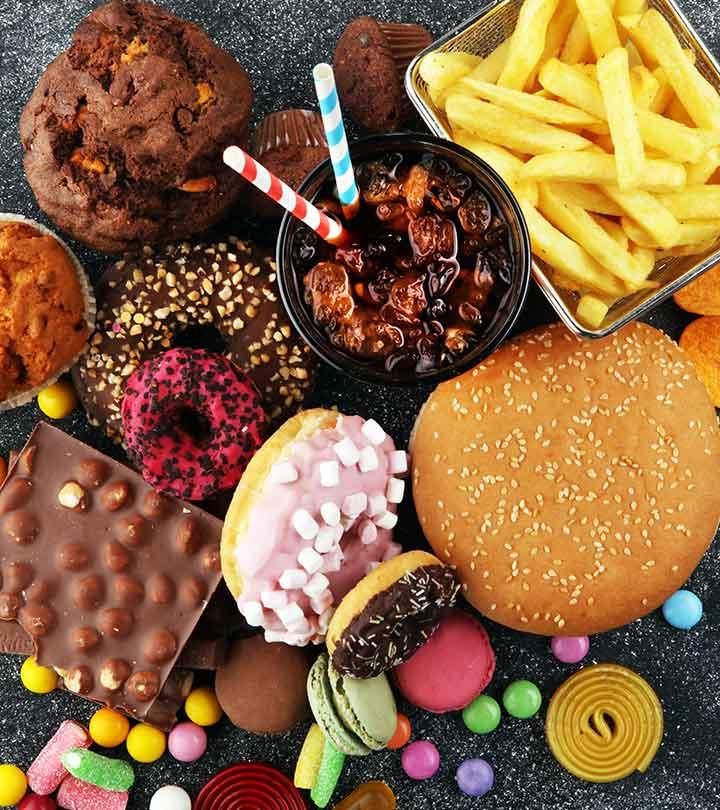Paleo Diet: Types, Health Benefits, And Meal Plan
Eat like your ancestors to shed those extra pounds and live a healthy life!

Image: Shutterstock
Going back to nature has always proved to be an effective solution for several ailments and that is exactly what the paleo diet can help with. It became popular in the 21st century and offers a peek into the eating patterns of our ancestors during the Paleolithic age. From whole foods to meat to vegetables and nuts, these foods can help improve your overall health and well-being. This article explores the benefits and the potential risks of following the paleo diet. Keep reading to discover how to create a well-rounded meal plan that nourishes your body while delighting your taste buds.
 At A Glance: Paleo Diet
At A Glance: Paleo Diet- Principle: Consuming whole foods and limiting grains, legumes, and dairy products.
- Purpose: To lose weight and manage blood pressure and cholesterol levels.
- Who It Is For: Individuals who want to lose weight
- Duration: Both long- and short-term, depending on preferences.
- Who Should Avoid: Pregnant and breastfeeding women and those with eating disorders.
- Cons: May cause vitamin and calcium deficiencies.
In This Article
What Is The Paleo Diet?

The paleo diet, also known as the caveman diet or Stone Age diet, focuses on consuming foods that may have been available during the Paleolithic age. This includes whole foods they could hunt and gather, such as fish, lean meats, fruits, vegetables, nuts, and seeds.
The proponents of this diet believe that these foods may help prevent health issues like diabetes, heart disease, and obesity. It also eliminates grains, dairy, and legumes as it is believed that the human body is not fully evolved to process these foods, resulting in health issues.
 Trivia
TriviaHowever, not everyone follows the diet in a very strict manner. It can be adjusted as per the individual’s requirements. Scroll down to learn about the different types of the diet.
Types Of Paleo Diet
Some people customize their diet plan as per their health goals. There are modified versions of the diet that may not be as strict as the original paleo diet. These include:
- Primal Paleo Diet: This diet includes white rice, dark chocolate, fermented dairy products, raw honey, and maple syrup, as well as certain alcoholic drinks.
- Normal Paleo Diet: This diet allows dark chocolate, ghee, butter, raw honey, maple syrup, and wine.
- Autoimmune Paleo Diet: This is an elimination diet that involves removing foods from your diet one by one to identify the ones causing symptoms related to autoimmune diseases.
Though the diet can be adjusted as per your needs, it improves your health in various ways. Take a look.
Benefits Of The Paleo Diet
- May Aid In Weight Loss

A meta-analysis found that the paleo diet may help reduce weight, BMI, and waist circumference (1). Though it is considered a fad diet, it may help in weight loss because of decreased caloric intake (2).
- May Help Treat Diabetes
The reduced intake of saturated fatty acidsi XA type of fat molecule found in animal products like meat and dairy, as well as plant-based oils like coconut oil and palm oil. and carbohydrates and higher intake of protein, monounsaturated and polyunsaturated fatty acids may help improve glycemic controli XThe regulation and maintenance of blood sugar levels within a specific target range to promote optimal health. and reduce postprandial hyperglycemiai XElevated blood sugar levels that develop after eating a meal or consuming carbohydrate-rich foods. (3). A study found that short-term adherence to this diet may increase insulin sensitivityi XThe body's ability to respond effectively to the hormone insulin, which helps regulate blood sugar levels efficiently. and improve lipid profilesi XA panel of blood tests that measure various types of fats (lipids) in your blood and help assess your heart health. (4).
- May Help Reduce Blood Pressure
Studies suggest that the paleo diet may help lower both systolic and diastolic blood pressurei XThe lower number in a pressure reading that measures the force in the arteries when the heart rests between beats. due to the reduced sodium intake and weight loss (3), (5). This may help improve several cardiovascular risk factors in people with metabolic syndromei XA cluster of conditions that increase the risk of coronary heart disease, stroke, and type 2 diabetes. .
- May Help Improve Cholesterol Levels
Studies show that consuming a grain-free diet can lower total cholesterol, LDL-cholesteroli XA type of lipoprotein that carries cholesterol in the bloodstream and contributes to plaque buildup in the arteries. , and triglyceridei XA common type of fat that comes from the foods you eat and high levels of which may increase the risk of heart disease. levels (5), (6). However, the exact mechanism behind this is yet to be studied, but it is believed that a grain-free diet is lower in carbohydrate and sugar content, which are the main culprit behind LDL cholesterol. Therefore, following this diet may help manage high cholesterol levels and reduce the risk of heart issues.
This diet helps improve your health in various ways but to avail its benefits, scroll down to the next section for the foods to eat and exclude from this diet.
Foods To Eat On The Paleo Diet
- Fruits: Apples, plums, peaches, bananas, grapes, citrus fruits, melons, and berries.
- Vegetables: Cauliflower, spinach, cabbage, butter squash, sweet potatoes, broccoli, Brussel sprouts, and turnips.
- Meat And Seafood: Chicken, beef, salmon, tuna, pork, bacon, cod, and turkey.
- Eggs: Free-range, pastured, or omega-3 enriched eggs.
- Nuts And Seeds: Chia seeds, flax seeds, sunflower seeds, pumpkin seeds, almonds, pine nuts, pistachios, pecans, hazelnuts, Brazil nuts, macadamia nuts, and walnuts.
- Healthy Oils And Fats: Olive oil, walnut oil, coconut oil, flaxseed oil, macadamia oil, and avocado oil.
While these are the various foods you can eat on this diet, it is also important to know the foods you should avoid. Take a look.
Foods To Avoid On The Paleo Diet
- Grains: Wheat, rye, barley, cereal, bread, and pasta.
- Legumes: Beans, lentils, soy flour, peanuts, peas, tofu, and soy milk.
- Dairy: All dairy products, including low-fat milk.
- Refined Or Added Sugar: Soft drinks, fruit juices, table sugar, candy, pastries, and ice cream.
- Vegetables: Starchy vegetables like corn, jicama, and white potatoes.
- Vegetable Oils: Soybean oil, safflower oil, grapeseed oil, sunflower oil, cottonseed oil, and corn oil.
- Highly Processed Foods: Chips, cookies, everything labeled “low fat, or with many additives, including artificial meal replacements.
Now that you know about the various foods to include and avoid, scroll down to a sample meal plan to help you get started.
Paleo Diet Meal Plan
Here is a sample meal plan to help you get started:
Paleo Diet 7-Day Meal Plan
| DAYS | BREAKFAST | LUNCH | DINNER | SNACK |
|---|---|---|---|---|
| Day 1 | Scrambled eggs made 3 large eggs and sautéed spinach, tomatoes, bell peppers, and mushrooms | 1 bowl of chicken salad with olive oil dressing, cucumber, mixed berries, avocado, and a handful of nuts. | 3 ounces of strips of grilled steak with a bowl of spinach salad topped with sunflower seeds | A handful of almond slices and mixed berries. |
| Day 2 | 1 banana, avocado, kale, and apple smoothie made with almond milk and 2 poached eggs. | 1 serving of chicken salad with a cup of mixed grilled vegetables and 1 cup of grapes. | 6 ounces of baked salmon with 6 steamed asparagus spears, a cup of steamed broccoli, and roasted sweet potatoes. | A few slices of citrus fruit along with 1 cup of herbal tea. |
| Day 3 | 1 serving of banana, avocado, kale, and apple smoothie with a sprinkle of chia seeds and 1 poached egg. | 1 bowl of mixed salad with tuna, pumpkin seeds, olive oil, cherry tomatoes, cucumber, bell peppers, and boiled eggs. | 4 ounces of beef stir-fry cooked in 2 tablespoons coconut oil and a side of broccoli, bell peppers, and snap peas. | 1 glass of warm almond milk with 1 ounce of cashews, a banana, and a tablespoon of chia seeds. |
| Day 4 | 3 bacon slices with scrambled eggs made from 3 eggs and 1 orange. | 2 servings of chicken and vegetable soup with 15 grain-free crackers | 4 ounces of fried pork with steamed kale, broccoli, and spinach. | 3 ounces of beef jerky |
| Day 5 | 3 hard-boiled eggs with 1 cup of sliced carrots | 2 cups of mixed salad greens, 3 oz of grilled chicken breast, and a slice of avocado | 4 ounces of stir-fried ground beef with vegetables and berries. | A handful of walnuts and mixed berries. |
| Day 6 | 1 glass of smoothie made with spinach, mixed berries, 1 scoop of vegan protein powder, and coconut milk. | 4 ounces of baked salmon with 1 cup of roasted butternut squash in 1 tablespoon of and olive oil six roasted asparagus spears | 2 servings of mixed vegetable and chicken soup with turmeric. | A handful of roasted pumpkin seeds and almonds with 1 cup of herbal tea |
| Day 7 | 3-4 oz of Greek yogurt with 1 cup of roasted sweet potatoes with apple slices and cinnamon. | 1 bowl of mixed salad with turkey, seeds, avocado, and olive oil. | 4 ounces of grilled lamb with roasted Brussels sprouts and spaghetti squash. | 1 cup of herbal tea with a handful of mixed berries and walnuts. |
 Quick Tip
Quick TipThis sample meal plan can be of great help to beginners as well as people looking to lose weight. You may also customize the diet based on your food preferences and goals. If you do not feel like following a strict diet, you may also choose alternatives like the keto diet. While paleo and keto are interchangeably used, they are not the same. Read on to learn about the fundamental differences between the two.
Paleo Diet Vs. Keto Diet
The paleo diet and keto diet share some similarities as both promote the consumption of whole, unprocessed foods. However, they differ in the following ways.
| PALEO DIET | KETO DIET |
|---|---|
|
|
While the two diets differ in many ways, both aid in weight loss and improve your overall health. However, it is important to learn about its potential risks before starting it. Scroll down to know more.
Risks Of The Paleo Diet
- The diet restricts several foods such as grains and starchy vegetables that are good sources of fiber and other nutrients. This may cause nutrient deficiencies.
- The elimination of dairy products may result in calcium and vitamin D deficiencies. This may result in decreased bone density and increase the risk of osteoporosisi XA medical condition characterized by the weakening of bones, leading to a decrease in bone density and quality. , especially during menopause (7), (8).
- The diet is not sustainable for long-term adherence. Consult your physician or registered dietitian if you want to do the Paleo diet, especially for those with heart, kidney, liver, or pancreatic disease.
The paleo diet promotes the consumption of whole, unprocessed foods like lean meats, fish, fruits, vegetables, nuts, and seeds. It may aid in weight loss, improve blood sugar control, and reduce blood pressure levels. However, long-term adherence of this restrictive diet may cause nutrient deficiencies. So, you may either fully adopt its principles into your existing diet or tailor it according to your individual health goals and needs. Also, consult a registered dietitian for guidance, especially if you have underlying health conditions.
Frequently Asked Questions
Should you stay on the paleo diet forever?
No, the paleo diet is not recommended for long-term adherence as it may cause calcium and vitamin D deficiencies (8). Therefore, it is best to stop it after a month or two.
Do doctors recommend a paleo diet?
Not all doctors may recommend this diet. Anecdotal evidence suggests that a doctor may recommend it for immediate weight loss but not as a long-term solution to improve your health.
Key Takeaways
- The paleo diet focuses on consuming whole, unprocessed foods that our Paleolithic ancestors would have eaten.
- It may aid in weight loss and reduce blood pressure levels.
- The diet’s restive nature may cause nutrient deficiencies.

Image: Stable Diffusion/StyleCraze Design Team
If you are a beginner looking to shed some pounds quickly, the paleo diet might be the solution you are looking for! Check out this video for the ultimate food list and essential rules for following this diet.
References
Articles on StyleCraze are backed by verified information from peer-reviewed and academic research papers, reputed organizations, research institutions, and medical associations to ensure accuracy and relevance. Read our editorial policy to learn more.
- Influence of Paleolithic diet on anthropometric markers in chronic diseases: systematic review and meta-analysis
https://www.ncbi.nlm.nih.gov/pmc/articles/PMC6647066/ - Popular weight loss strategies: A review of four weight loss techniques
https://link.springer.com/article/10.1007/s11894-017-0603-8 - Effects of a Paleolithic diet with and without supervised exercise on fat mass insulin sensitivity and glycemic control: A randomized controlled trial in individuals with type 2 diabetes
https://www.ncbi.nlm.nih.gov/pmc/articles/PMC5402870/ - Metabolic and physiologic improvements from consuming a paleolithic hunter-gatherer type diet
https://www.nature.com/articles/ejcn20094 - Favourable effects of consuming a Palaeolithic-type diet on characteristics of the metabolic syndrome: A randomized controlled pilot-study
https://pubmed.ncbi.nlm.nih.gov/25304296/ - Paleolithic nutrition improves plasma lipid concentrations of hypercholesterolemic adults to a greater extent than traditional heart-healthy dietary recommendations
https://pubmed.ncbi.nlm.nih.gov/26003334/ - Calcium and osteoporosis
https://pubmed.ncbi.nlm.nih.gov/9263260/ - Nutritional adequacy comparison of Paleo and healthy U.S.dietary patterns followed by athletic adults
https://commons.emich.edu/cgi/viewcontent.cgi?article=2434&context=theses







